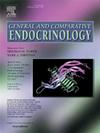Endocrine regulation of feeding in non-transgenic and transgenic fluorescent orange tiger barb (Puntigrus tetrazona)
IF 1.7
3区 医学
Q3 ENDOCRINOLOGY & METABOLISM
引用次数: 0
Abstract
Tiger barbs are popular tropical aquarium fish but despite their economic importance, nothing is known about their feeding physiology, in particular their endocrine regulation of feeding. The tiger barb has also been used to make genetically modified fluorescent fish but the influence of this genetic modification on their physiology is poorly understood. In this study, we submitted both non-transgenic (NT) and transgenic fluorescent orange (T) fish to 2 weeks of fasting or different temperatures (20, 25 and 30 °C) and assessed food intake and the expression of appetite regulators in brain, intestine and liver. Fasting had no effect on appetite regulators in the intestine, and decreased liver leptin expression in NT fish only. Fasting caused an overall increase and decrease in brain orexigenic and anorexigenic factors, respectively. The nature of peptides affected by this response differed between strains (MCH, ghrelin, POMCb in both NT and T, orexin in NT only, CRF and CCK in T only). In both T and NT fish, increasing temperatures increased food intake. Temperature affected the expression of most of the peptides examined, but the effects differed between the two fish strains. A shift from 25 to 20 °C increased hepatic leptin in NT and T, and intestine ghrelin in NT and had no effect on brain expression. A shift from 25 to 30 °C did not affect intestine or liver expressions, increased orexin, MCH and CRF brain expression in NT and T, and increased POMCb and CCKa expressions in T. Our study presents new information on the endocrine regulation of feeding in tiger barb, and provides insights on how transgenesis might affect feeding physiology of fish.
非转基因和转基因荧光橙虎倒钩摄食的内分泌调节
虎刺鱼是一种很受欢迎的热带观赏鱼,尽管它们具有重要的经济价值,但人们对它们的摄食生理,特别是它们对摄食的内分泌调节机制一无所知。老虎的倒刺也被用来制造转基因荧光鱼,但这种基因改造对其生理的影响尚不清楚。在这项研究中,我们将非转基因(NT)和转基因荧光橙(T)鱼分别置于禁食2周或不同温度(20、25和30°C)下,评估食物摄入量和大脑、肠道和肝脏中食欲调节因子的表达。禁食对NT鱼的肠道食欲调节因子没有影响,而肝脏瘦素表达降低。禁食分别引起脑促氧因子和厌氧因子的总体增加和减少。受这种反应影响的肽的性质在菌株之间是不同的(NT和T中都有MCH、ghrelin、POMCb, NT中仅有orexin, T中仅有CRF和CCK)。在T型鱼和NT型鱼中,温度升高会增加食物摄入量。温度影响了大多数肽的表达,但影响在两种鱼株之间有所不同。从25°C到20°C的变化增加了NT和T中的肝脏瘦素,以及NT中的肠饥饿素,而对脑表达没有影响。从25°C到30°C的变化不影响肠道和肝脏的表达,增加了NT和T中orexin, MCH和CRF的脑表达,增加了T中POMCb和CCKa的表达。我们的研究为虎倒刺摄食的内分泌调节提供了新的信息,并为转基因如何影响鱼类的摄食生理提供了新的见解。
本文章由计算机程序翻译,如有差异,请以英文原文为准。
求助全文
约1分钟内获得全文
求助全文
来源期刊

General and comparative endocrinology
医学-内分泌学与代谢
CiteScore
5.60
自引率
7.40%
发文量
120
审稿时长
2 months
期刊介绍:
General and Comparative Endocrinology publishes articles concerned with the many complexities of vertebrate and invertebrate endocrine systems at the sub-molecular, molecular, cellular and organismal levels of analysis.
 求助内容:
求助内容: 应助结果提醒方式:
应助结果提醒方式:


